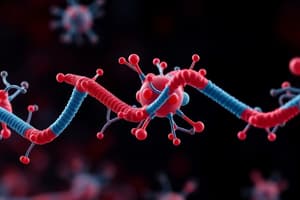Podcast
Questions and Answers
What is the value of KD for ATP based on the given data?
What is the value of KD for ATP based on the given data?
- 0.5 mM
- 7.7 µM (correct)
- 15 mM
- 152 µM
Which compound has a higher KD value, ATP or GAP?
Which compound has a higher KD value, ATP or GAP?
- Both have the same KD
- GAP (correct)
- ATP
- Neither has a measurable KD
What is the numerical value of KD for GAP?
What is the numerical value of KD for GAP?
- 8 µM
- 5 mM
- 10 µM
- 152 ± 19 µM (correct)
How does the n value relate to the binding affinity of ATP?
How does the n value relate to the binding affinity of ATP?
What does a lower KD value indicate regarding the affinity of a ligand for its receptor?
What does a lower KD value indicate regarding the affinity of a ligand for its receptor?
What is the effect of increasing NaCl concentrations on ATP-binding affinity in OEP21?
What is the effect of increasing NaCl concentrations on ATP-binding affinity in OEP21?
What role does Mg2+ play in the context of ATP interactions within the cell?
What role does Mg2+ play in the context of ATP interactions within the cell?
How does the deletion of L5 affect the high-affinity binding site in OEP21?
How does the deletion of L5 affect the high-affinity binding site in OEP21?
What was the observed effect of GAP on NMR signals in the presence of OEP21?
What was the observed effect of GAP on NMR signals in the presence of OEP21?
What is the translocation frequency of GAP with OEP21ΔL5 compared to with OEP21?
What is the translocation frequency of GAP with OEP21ΔL5 compared to with OEP21?
What is the consequence of GAP binding, as indicated by the NMR analysis?
What is the consequence of GAP binding, as indicated by the NMR analysis?
Which positively charged residues are provided by L5 that interact with OEP21?
Which positively charged residues are provided by L5 that interact with OEP21?
What is the effect of applying a 180 mV membrane potential during the simulation?
What is the effect of applying a 180 mV membrane potential during the simulation?
What effect does the addition of L5 have on translocation?
What effect does the addition of L5 have on translocation?
What is the effect of Mg2+ on translocation?
What is the effect of Mg2+ on translocation?
In which part of the cell is Loop 5 located?
In which part of the cell is Loop 5 located?
What molecular weight is indicated for the sample showing no translocation?
What molecular weight is indicated for the sample showing no translocation?
Which of the following amino acids is indicated near Loop 5?
Which of the following amino acids is indicated near Loop 5?
What is the primary focus of the research article mentioned?
What is the primary focus of the research article mentioned?
What does the acronym GAP refer to in the context given?
What does the acronym GAP refer to in the context given?
What were the two controls measured alongside the translocation assays?
What were the two controls measured alongside the translocation assays?
Which amino acid is found at position E149?
Which amino acid is found at position E149?
What does the presence of no translocation indicate about the experimental results?
What does the presence of no translocation indicate about the experimental results?
What effect do GAP and Mg2+ have on the dissociation of ATP from OEP21?
What effect do GAP and Mg2+ have on the dissociation of ATP from OEP21?
What was the IC50 value for the OEP21-ATP complex when inorganic phosphate was added?
What was the IC50 value for the OEP21-ATP complex when inorganic phosphate was added?
Which factor contributed to the relatively high GAP concentrations required for ATP dissociation?
Which factor contributed to the relatively high GAP concentrations required for ATP dissociation?
How does the binding affinity of Mg2+ compare with that of ATP and phosphate?
How does the binding affinity of Mg2+ compare with that of ATP and phosphate?
What is indicated by the KD values for ATP determined with the set of OEP21 variants?
What is indicated by the KD values for ATP determined with the set of OEP21 variants?
What role do positive charges play in the binding of phosphorylated metabolites to OEP21?
What role do positive charges play in the binding of phosphorylated metabolites to OEP21?
What was observed about the structural integrity of the OEP21 variants produced?
What was observed about the structural integrity of the OEP21 variants produced?
Which variant of OEP21 was noted to have a lower binding affinity during the experiments?
Which variant of OEP21 was noted to have a lower binding affinity during the experiments?
What is the significance of a 1:1 molar ratio in the context of this data?
What is the significance of a 1:1 molar ratio in the context of this data?
What does 'fold increase in KD for ATP' suggest about ATP's interaction?
What does 'fold increase in KD for ATP' suggest about ATP's interaction?
Why might excess ATP affect KD values?
Why might excess ATP affect KD values?
What could be inferred if the fold increase in KD is significantly greater than 1?
What could be inferred if the fold increase in KD is significantly greater than 1?
The graphical representation appears to show relationships between which variables?
The graphical representation appears to show relationships between which variables?
What conclusion can be made from a lower fold increase in KD?
What conclusion can be made from a lower fold increase in KD?
When assessing ligand-receptor interactions, what does a KD value represent?
When assessing ligand-receptor interactions, what does a KD value represent?
How might ATP's concentration affect receptor activation?
How might ATP's concentration affect receptor activation?
How does temperature likely influence the folding and activity of proteins in this context?
How does temperature likely influence the folding and activity of proteins in this context?
Which factor could potentially disrupt KD values in ligand-receptor studies?
Which factor could potentially disrupt KD values in ligand-receptor studies?
What role does the term 'relative' play in the studied interactions?
What role does the term 'relative' play in the studied interactions?
If the dataset includes terms like R1 A, what could these represent?
If the dataset includes terms like R1 A, what could these represent?
What is the implication of the term 'excess ATP' in the study?
What is the implication of the term 'excess ATP' in the study?
What effect does the addition of ATP have on the NMR spectral signals?
What effect does the addition of ATP have on the NMR spectral signals?
What was observed concerning the intrinsic flexibility of the protein when ATP was added?
What was observed concerning the intrinsic flexibility of the protein when ATP was added?
Which observation indicates the stabilization effect of ATP on OEP21?
Which observation indicates the stabilization effect of ATP on OEP21?
What does the KD for ATP represent?
What does the KD for ATP represent?
In the context of OEP21, what is the significance of the term 'solvent accessibility'?
In the context of OEP21, what is the significance of the term 'solvent accessibility'?
What might the structural indication of 'flexible L5' imply about the protein's functionality?
What might the structural indication of 'flexible L5' imply about the protein's functionality?
Why is trypsin mentioned in the context of this study?
Why is trypsin mentioned in the context of this study?
What does the presence of higher oligomer states indicate about OEP21?
What does the presence of higher oligomer states indicate about OEP21?
How does the term 'unfolded' relate to the protein structure discussed?
How does the term 'unfolded' relate to the protein structure discussed?
Which factor could potentially lower the KD for ATP binding to OEP21?
Which factor could potentially lower the KD for ATP binding to OEP21?
What could be inferred about the ATP binding mechanism to OEP21?
What could be inferred about the ATP binding mechanism to OEP21?
What role do molecular weight (MW) markers play in the experiments discussed?
What role do molecular weight (MW) markers play in the experiments discussed?
What does the acronym 'NOE' in NMR stand for?
What does the acronym 'NOE' in NMR stand for?
What impact does the solvent LDAO have on the study of OEP21?
What impact does the solvent LDAO have on the study of OEP21?
Flashcards
KD (dissociation constant)
KD (dissociation constant)
A measure of the concentration of a ligand (like ATP or GAP) needed to achieve half-maximal binding to a protein.
Hill coefficient (n)
Hill coefficient (n)
The Hill coefficient describes the cooperativity of binding. A value greater than 1 indicates positive cooperativity, meaning binding of one ligand increases the affinity for subsequent ligands.
KD for ATP
KD for ATP
The concentration of ATP required to achieve half-maximal binding to the protein in this study.
KD for GAP
KD for GAP
Signup and view all the flashcards
ATP and GAP binding affinities differ
ATP and GAP binding affinities differ
Signup and view all the flashcards
Loop
Loop
Signup and view all the flashcards
Cytosol
Cytosol
Signup and view all the flashcards
Endoplasmic Reticulum (ER)
Endoplasmic Reticulum (ER)
Signup and view all the flashcards
Golgi Apparatus
Golgi Apparatus
Signup and view all the flashcards
Translocation
Translocation
Signup and view all the flashcards
Conformational Change
Conformational Change
Signup and view all the flashcards
Cation
Cation
Signup and view all the flashcards
Anion
Anion
Signup and view all the flashcards
Ionic Strength
Ionic Strength
Signup and view all the flashcards
Loop 5
Loop 5
Signup and view all the flashcards
How do GAP and Mg2+ affect ATP dissociation from OEP21?
How do GAP and Mg2+ affect ATP dissociation from OEP21?
Signup and view all the flashcards
What does the similar KD values for ATP in OEP21 variants suggest?
What does the similar KD values for ATP in OEP21 variants suggest?
Signup and view all the flashcards
How does Mg2+ affect the binding affinity of ATP to OEP21?
How does Mg2+ affect the binding affinity of ATP to OEP21?
Signup and view all the flashcards
How does inorganic phosphate compare to GAP and Mg2+ in terms of ATP dissociation?
How does inorganic phosphate compare to GAP and Mg2+ in terms of ATP dissociation?
Signup and view all the flashcards
What is the significance of the observed phosphate concentration for ATP dissociation?
What is the significance of the observed phosphate concentration for ATP dissociation?
Signup and view all the flashcards
Why are high concentrations of GAP required for ATP dissociation?
Why are high concentrations of GAP required for ATP dissociation?
Signup and view all the flashcards
How does Mg2+ interact with ATP, GAP, and phosphate?
How does Mg2+ interact with ATP, GAP, and phosphate?
Signup and view all the flashcards
What binding site do phosphorylated metabolites use on OEP21?
What binding site do phosphorylated metabolites use on OEP21?
Signup and view all the flashcards
Promiscuous Binding
Promiscuous Binding
Signup and view all the flashcards
OEP21's Dependence on Charge
OEP21's Dependence on Charge
Signup and view all the flashcards
Role of Salt Concentration on OEP21 Binding
Role of Salt Concentration on OEP21 Binding
Signup and view all the flashcards
Loop L5's Role in Translocation
Loop L5's Role in Translocation
Signup and view all the flashcards
Effect of L5 Removal on Translocation
Effect of L5 Removal on Translocation
Signup and view all the flashcards
Molecular Dynamics and Simulations
Molecular Dynamics and Simulations
Signup and view all the flashcards
Positive Charges in Translocation
Positive Charges in Translocation
Signup and view all the flashcards
Membrane Potential in Simulation
Membrane Potential in Simulation
Signup and view all the flashcards
Intrinsic flexibility
Intrinsic flexibility
Signup and view all the flashcards
L5 region
L5 region
Signup and view all the flashcards
ATP's effect on OEP21
ATP's effect on OEP21
Signup and view all the flashcards
NMR Spectroscopy
NMR Spectroscopy
Signup and view all the flashcards
Nuclear Overhauser Effect (NOE)
Nuclear Overhauser Effect (NOE)
Signup and view all the flashcards
Solvent Accessibility
Solvent Accessibility
Signup and view all the flashcards
Crosslinking
Crosslinking
Signup and view all the flashcards
Denaturant
Denaturant
Signup and view all the flashcards
OEP21
OEP21
Signup and view all the flashcards
Trypsin
Trypsin
Signup and view all the flashcards
Unfolded
Unfolded
Signup and view all the flashcards
Oligomeric State
Oligomeric State
Signup and view all the flashcards
δ1( N) and δ2( H)
δ1( N) and δ2( H)
Signup and view all the flashcards
Fold increase in KD
Fold increase in KD
Signup and view all the flashcards
1:1 molar ratio
1:1 molar ratio
Signup and view all the flashcards
Excess ATP
Excess ATP
Signup and view all the flashcards
T
T
Signup and view all the flashcards
K1, K15, R3, R5, R6, K9, C4, R19, R1, R12, R17
K1, K15, R3, R5, R6, K9, C4, R19, R1, R12, R17
Signup and view all the flashcards
A, W, N, R
A, W, N, R
Signup and view all the flashcards
∆L
∆L
Signup and view all the flashcards
Fold increase in KD for ATP
Fold increase in KD for ATP
Signup and view all the flashcards
Rel. >1
Rel. >1
Signup and view all the flashcards
90°
90°
Signup and view all the flashcards
Center
Center
Signup and view all the flashcards
R6, R66, R142, R157, R33, R174, K104, K90, K19
R6, R66, R142, R157, R33, R174, K104, K90, K19
Signup and view all the flashcards
T, 6A, 6W, A, W
T, 6A, 6W, A, W
Signup and view all the flashcards
Fold increase in KD > 1
Fold increase in KD > 1
Signup and view all the flashcards
Bars
Bars
Signup and view all the flashcards
Study Notes
Structural Basis of Metabolite Transport by the Chloroplast Outer Envelope Channel OEP21
- Triose phosphates (TPs) are the primary products of photosynthesis.
- TPs need to be exported from chloroplasts into the cytosol, crossing both the inner and outer envelopes (IE and OE).
- OEP21, a transporter protein in the chloroplast outer envelope, is the main exit pore for TPs in C3 plants.
- OEP21 has a cone-shaped beta-barrel structure with a highly positively charged interior.
- This positive charge allows binding and translocation of negatively charged metabolites like TPs, and to some extent, molecules up to ~1 kDa.
- ATP stabilizes the OEP21 channel, keeping it open.
- OEP21 has broad substrate selectivity, enabling transport of various metabolites.
- The abundance of OEP21 can change in different plant species reflecting various metabolite fluxes.
- OEP21 likely operates passively using a concentration gradient.
- Its interaction with ATP can serve as a regulatory mechanism, potentially impacting the opening status of OEP21 channel, affecting downstream metabolic processes.
Orientation and Oligomeric State of OEP21
- OEP21's funnel shape suggests an outward-rectifying orientation, with the wider opening towards the intermembrane space (IMS).
- Limited proteolysis experiments with isolated chloroplast outer envelope vesicles confirmed the cytoplasmic orientation of loop 5 (L5) in OEP21. The N and C termini were located in the IMS.
- OEP21 forms oligomers, with the oligomeric state potentially regulated by ATP, either impacting the degree of oligomerization or interacting dynamically with the pore.
- OEP21 can form dimers and higher-order oligomers; ATP binding may lead to partial reduction in oligomer formation.
- The presence of loop 5 (L5) impacts transport efficiency, with its removal leading to improved translocation.
OEP21 Metabolite Binding
- OEP21's interactions with metabolites are charge-dependent, with ATP binding with a high affinity, and exhibiting a 1:1 molar ratio of interaction.
- Metabolites like GAP or phosphate can compete with ATP for binding.
- The presence of Mg2+ can modulate the binding affinity and transport kinetics of certain metabolites.
Size-Selective Metabolite Translocation
- OEP21's structure permits the passage of metabolites up to ~1 kDa.
- Molecules larger than ~1 kDa (vitamin B12, lysozyme) cannot transit.
- The OEP21 channel's selectivity permits preferential movement of negative charges.
- MD simulations suggest that GAP translocation across the OEP21 channel involves transient interactions with positively charged pore regions and translocation occurs in the microseconds-to-milliseconds timescale..
- ATP can enhance or maintain the open state and thus regulate translocation of metabolites like GAP, across the pore.
Studying That Suits You
Use AI to generate personalized quizzes and flashcards to suit your learning preferences.




